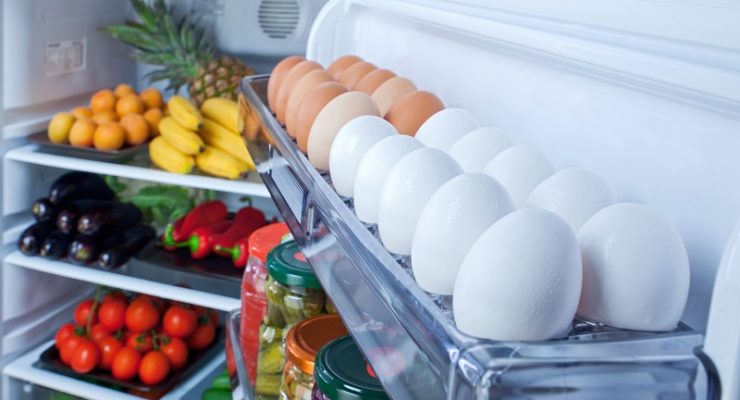If you’re doing your annual house clean-up, start with your kitchen organization. You could eat healthier and lose weight as a result.
Reorganizing your kitchen isn’t just going to make it easier for you to find your favorite spatula or locate the curry powder for a recipe. It also could curb the noshing that makes the calories—and pounds—add up. A 2016 study, published in the journal Environment and Behavior found, that messy, cluttered kitchens really can make you eat more. Women in the study who were given snacks in two situations—a cluttered kitchen and one that was neat and tidy—ate 103 more calories in the messy kitchen than in the orderly one.
Here are a few great kitchen organization ideas that will help you both feel and eat better:
1. Get rid of old, expired foods.

Not only do foods that have been hanging around for a while lose freshness and flavor—and in some cases, spoil—but you’ll need the shelf space for your Nutrisystem foods and other healthy eats. In particular, give your herbs and spices the sniff and taste test. They don’t typically spoil but they do lose their potency and flavor. If they taste or smell “meh,” replace them. Your diet will automatically improve. Herbs and spices added to food can make them more flavorful so you don’t miss the fat, salt and sugar you’re removing to save calories. For example, a dash of cinnamon can help you not miss the sugar you once liberally sprinkled on your oatmeal, while pepper or cumin can “spice up” a savory dish so you don’t need salt and butter, say experts at the University of Florida.
2. Donate foods that aren’t on your diet or that you won’t eat.

Your local food bank can use those unopened packages of chips, cake mixes, sugary cereal, cookies, snack bars, and mac and cheese much more than you can. Find a food pantry near to help those in need.
3. Rearrange your counter.

As the old joke goes, you want to put yourself on the “see-food diet.” But change the old punchline, “I see food and I eat it.” You want to have healthy foods you want to eat where you can see them. So store fruit that doesn’t need refrigeration, like apples and bananas, in a bowl on the counter for easy snacking. Break down large containers of healthy snacks like nuts into single serving packets that you store in a clear container. Toss your Nutrisystem snacks into a wire basket where they’ll remind you to eat healthy treats. Several studies found people who kept just fruit on their kitchen counter had a lower Body Mass Index (BMI) than those who stored candy, cereal and sugary sodas up front and center.
4. Get scrubbing.

Before you can really jump into the rest of these kitchen organization hacks and ideas, you have to do some true cleaning. After pulling everything out of your fridge and off your pantry shelves, this is your chance to give everything a thorough wipe-down. Use antibacterial wipes to clean up any spills or crumbs. Conditions inside the fridge are optimal for mold growth, and food and drink spills enable cross-contamination. Wipe down handles and all of the cracks and crevices. This will create a clean space to house all of your organized healthy ingredients. Don’t forget to wipe down your countertops and cabinets, too!
Click the link below for some tips on cleaning out your fridge:
5. Invest in clear containers for your pantry and fridge.

When it comes to kitchen organization hacks, containers are one of the most popular purchases. They look great and can help you see all of your produce and healthy ingredients at first glance. Use these clear containers to store your pre-cut veggies and fresh fruit for easy meal prep. You can also invest in mason jars and clear containers for the pantry to store baking ingredients, cereal, rice, quinoa and pasta. This will help you whip up a healthy salad or stir fry quickly or grab a handful of berries or grapes for a snack. Conversely, store tempting foods and leftovers in opaque containers or wrap them in aluminum foil so they’ll be less identifiable—and less tempting.
6. Plan ahead.

Plan your meals for a week and make a shopping list before you head to the food store. (Bonus: Experts say sticking to your list while you’re wheeling your cart around the store can save you 20 percent or more on grocery bills.) When you get home, spend some time doing some meal prep by cutting up veggies and fruit and measuring out ingredients. Place meal ingredients in plastic freezer bags and mark them with the day you plan to eat them, then store in the fridge (for food like dairy products, produce or fruit), freezer (for meats or frozen vegetables) or a pantry cabinet (for dry goods). If you have the room, set up a restaurant-style menu board that reminds you of the “house specials” every day so you’re not tempted by cravings.
7. Tape nutrition information to your clear containers.

You can simply cut out the name and nutrition facts from the original packaging and tape them onto your clear containers. This is a great psychological trick to discourage you from overdoing. If you know the calorie, fat, sugar and sodium counts of foods, you’re less likely to eat more than you should. It’s also helpful for keeping track of your meals in the NuMi app.
Don’t forget to also take note or cut out the expiration date when transferring your ingredients. Feel free to purchase pretty labels for this task; they make kitchen organization a breeze.
8. Be choosy about what appliances take up counter space.

Prioritize the appliances that make whipping up a healthy meal quick and easy, such as air fryers, Instant Pots, spiralizers and blenders for smoothies. If you have enough counter real estate, keep your slow cooker within reach to prepare delicious, low-cal healthy meals while you’re at work so you’re not tempted to eat while you’re making dinner. Try out these six healthy slow cooker recipes! >
9. Rethink your cabinets.

Some studies have found that eating from smaller plates and bowls can help you eat less. It makes sense if you think about it. If you served the amount of food you can fit on a salad plate on a larger dinner plate, all that empty space would make you feel like you’re missing something. But on the salad plate, your meal looks like plenty. So move your salad plates and small bowls to the most reachable shelf and shift larger plates to a higher shelf so they’re less accessible.
10. Pull measuring utensils out of their drawer.

Individual measuring cups—usually available in 1 cup, ½ cup, ¼ cup and 1/3 cup increments—are easy to store on a hook under a cabinet so they’re within easy reach, as are spoons that come in 1 Tablespoon, 1 teaspoon, ½ teaspoon and ¼ teaspoon measures. That will eliminate the tendency to eyeball measurements of high-calorie ingredients such as butter, oil, sugar and even peanut butter. Because portion sizes have increased significantly in restaurants (and now at home), many of us have lost the ability to judge what’s an appropriate serving size, which may be why Americans are now eating 300 more calories a day compared to the year 1985, says the American Heart Association. Some dietitians call it “portion distortion.”
Using measuring cups and spoons can help you stay honest about how much you’re actually eating. As a bonus, after a few weeks or months of measuring, you may get better at “eyeballing” sizes and less likely to supersize everything.





